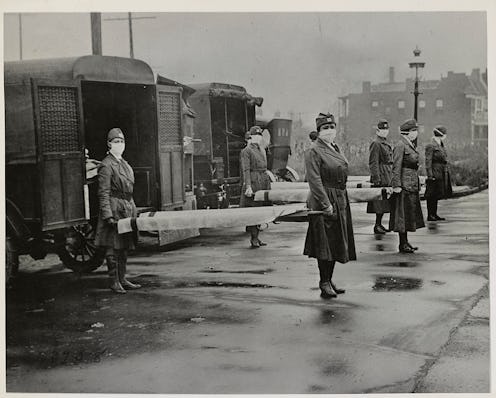Life
9 Old-Fashioned Ways People Used To Try To Prevent The Flu
The flu has been around in some form for thousands of years. The Greek physician Hippocrates is thought to have written about the flu as early as 412 B.C., and around that time, it was thought that the flu came from "bad air" or misfortune in the stars. It wasn't until the 20th century that doctors discovered how influenza really works and how to stop it. Today, we luckily have the flu shot as a safe and effective means of preventing the flu, but these old-fashioned ways to prevent the flu decidedly did not work (and are best left in the past).
Sometimes, the preventative measures of the past were quite effective. Italians of the 14th century, seeking to prevent plague from coming onto their shores with foreign traders, invented quarantine measures that seem very sensible to modern thinking, including 40 days of isolation, and washing materials like cloth under running water for 48 hours. Face masks designed to prevent the spread of infection were widely used in U.S. cities during the flu pandemic in 1918. But for every intelligent response to the threat of the flu virus, there have been dozens that were a lot less science-based, and a lot less functional.
1Avoiding "Nervous Exhaustion"
During the 1918 spread of Spanish flu throughout the world, which killed an estimated 50 million people, measures were desperately sought to prevent its movement across America. To that end, the American Public Health Association gave out some advisories, and in particular warned the population against "nervous and physical exhaustion." The warning was possibly particularly intended for women, who were supposed to be more susceptible to "nerves" and "hysteria" — and therefore deemed to be more vulnerable to flu.
2Amber Amulets
Around the United States, and particularly in the South, there's a strong history of folklore about amber amulets or beads as preventatives against flu, according to The History & Use of Amulets, Charms and Talismans by Gary R. Varner. Worn around the neck, they were meant to ward off influenza and cure it once it had arrived. Why amber in particular isn't really known — was it supposed to "trap" the flu inside it?
3Raw Onions On Plates
This one has been around for an incredibly long time; The National Onion Association traces it back to medieval preventative measures against the plague, but it travelled to the United States and became a firm folk prevention measure against flu by the 19th century. Onions, sliced or peeled, were meant to "absorb" the flu before it could get to any member of a household, so keeping one handy on a plate was supposed to be an excellent preventative strategy.
4Asafetida In A Bag Around The Neck
Asafetida, otherwise known as hing, is the spicy sap of a member of the carrot family, and carries a very strong smell. According to folklore records in Virginia in the 20th century, carrying a piece of it, or equally strong-smelling camphor, in a bag around the neck was meant to ward off infections like flu. While camphor can be helpful in relieving congestion caused by the flu, neither it nor this strong-smelling spice can cure it.
5Burning Sulphur And Orange Peel
19th century Nebraska was a hard place for settlers, and a record of their folk medicine traditions indicates that they were prepared to do virtually anything, including inhaling poisonous gases, to stay free of the flu. It was recommended that anybody wanting to protect their household should burn either orange peelings or sulphur on their stove-top, filling the house with smoke. The effects were, in the second case, probably not very healthy at all.
6Dirty Socks Under The Collar
A record of 19th century folk medicine in the Ozarks finds that asafetida bags were common there, but that there was an extra bit of local flavor. Children who were deemed vulnerable to flu were only sent outside if they had a dirty sock stuffed in their collars first. The logic behind it remains mysterious.
7Vinegar And Red Ribbons
Red as a color that flu "didn't like" pops up a lot in traditional folk medicine records about influenza protection. In the Ozarks, boys were given red bands to wind around their necks, while during the 1918 flu pandemic in America, it's recorded that a gentleman wrote to the Public Health Service advising that soldiers be told to wear red ribbons around their chests because "the Flu is the Devil and Devil don't work with Red." Needless to say, the flu doesn't respond differently to one color over the other.
8Whiskey With Bacon Grease
A collection of Polish-American folklore includes the the disgusting-sounding titbit that, during the 1918 flu pandemic, children were given "whiskey... [with] honey in it, and pepper, and maybe bacon grease or something." It was meant to be both a preventative and a cure, and probably burned a lot going down.
9Mistletoe Tea
Soaking mistletoe leaves in hot water and drinking the result as a tea may have been a preventative method for flu in Central Europe. Interestingly, taking mistletoe has been linked to "flu-like symptoms", so it's not clear whether the prevention here actually did good or simply made things worse.
10
Thankfully, our understanding of how the flu works has evolved considerably from these old-fashioned prevention methods. Want to know how to prevent the flu? Anyone who is able to get the flu shot this season should do so, and we should all be mindful to stay home if we get sick. No dirty socks necessary.
